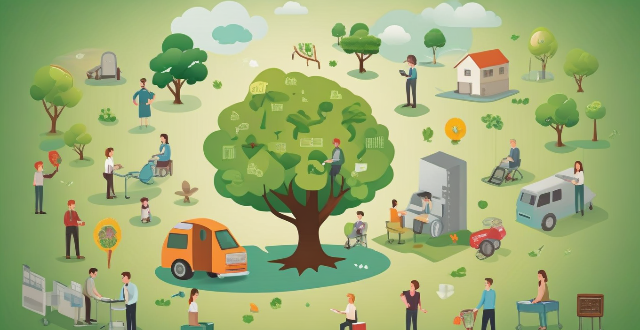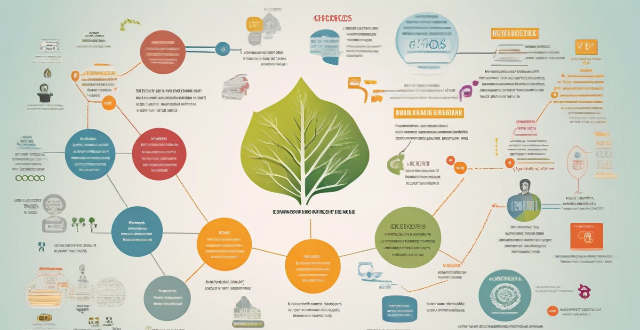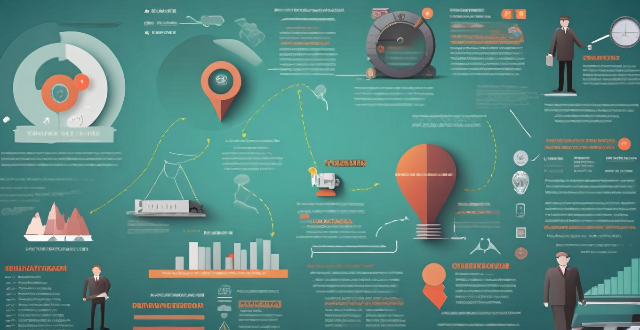Women Economy

How do female entrepreneurship programs contribute to economic growth and gender equality ?
Female entrepreneurship programs contribute to economic growth and gender equality by providing women with resources, training, and support. They create job opportunities, diversify the economy, and generate tax revenue. These programs also address challenges faced by women in business, such as access to capital, networking, and breaking down stereotypes. Overall, they promote a more diverse and innovative economy while fostering equal opportunities for all individuals regardless of gender.

How does a circular economy differ from a linear economy ?
The circular and linear economies are distinct models with different approaches to resource use, waste management, and sustainability. The linear economy follows a one-way flow of materials, extracting resources, processing them, consuming, and discarding as waste, focusing on continuous growth through increased consumption. In contrast, the circular economy aims to minimize waste and pollution by keeping resources in use for as long as possible through recycling, reusing, and regenerating products and materials. It focuses on creating a restorative and regenerative system by design. Key differences include the flow of resources, where the linear economy moves resources in a straight line from extraction to disposal, while the circular economy keeps resources in loops through recycling and regeneration. Economic growth is tied to increased consumption and throughput of resources in a linear economy, whereas it is decoupled from finite resources in a circular economy, emphasizing quality, longevity, and efficiency. Environmental impact is high in a linear economy due to excessive resource extraction, energy use, and waste accumulation, leading to pollution, habitat destruction, and climate change. In contrast, the circular economy has a lower environmental impact because it reduces waste and pollution by extending the life cycle of products and materials. Job creation and innovation are also different, with the linear economy centering jobs around resource extraction and processing, while the circular economy encourages job creation in recycling, refurbishing, and designing for longevity and recyclability. Transitioning from a linear to a circular economy presents challenges such as changing consumer behavior, investing in new technologies, redesigning supply chains, and updating legislation to support circular practices. However, it also offers opportunities such as reducing dependence on finite resources, stimulating green jobs and innovation, improving environmental quality, and fostering resilience against resource price volatility. Overall, the circular economy offers a pathway towards a more sustainable and resilient future for our planet.

What challenges do countries face in implementing circular economy policies ?
Implementing circular economy policies is a complex process that countries face numerous challenges. These include lack of awareness and understanding, economic and industrial structure, legal and regulatory framework, market conditions and business practices, as well as social and cultural factors. Addressing these challenges is crucial for the successful implementation of circular economy policies, which can bring significant environmental and socioeconomic benefits.

How might a lunar base influence the global economy and job market ?
The establishment of a lunar base could significantly impact the global economy and job market by increasing investment in space technology, creating new industries, driving innovation, and fostering international collaboration. It could also create numerous job opportunities and expand educational opportunities focused on space-related disciplines.

What are some successful examples of circular economy policies ?
The circular economy is a sustainable economic model that aims to minimize waste and pollution by keeping resources in use for as long as possible. Successful examples of circular economy policies include the European Union's Circular Economy Package, Netherlands' National Circular Economy Programme, China's Circular Economy Promotion Law, Japan's Sound Material-Cycle Society Act, and state-level initiatives in the United States. These policies focus on waste reduction, resource efficiency, extended producer responsibility, product stewardship, and public-private partnerships to promote a more sustainable future.

How can we create a sustainable economy that benefits both people and the planet ?
To create a sustainable economy that benefits both people and the planet, several strategies must be employed. These include shifting to renewable energy sources, promoting circular economy practices, encouraging green innovations and technology, implementing sustainable agriculture practices, supporting local economies and fair trade, and raising awareness and education about sustainability. By taking these steps, we can ensure the well-being of current and future generations while minimizing waste, reducing environmental impacts, and conserving natural resources.

How does a circular economy contribute to waste reduction and resource conservation ?
The circular economy model promotes waste reduction and resource conservation by advocating for the reuse and recycling of materials, reducing raw material extraction, extending product lifecycles, treating waste as a resource, encouraging the sharing economy and digital services, improving resource efficiency, promoting biodegradable and renewable resources, raising consumer awareness, and supporting regulatory policies. This approach challenges traditional linear economic models and offers a sustainable solution to address environmental issues related to waste and resource depletion.

What is the Consumer Confidence Index and how does it impact the economy ?
The Consumer Confidence Index (CCI) is a measure of consumer sentiment about the economy. It impacts the economy by serving as an indicator of economic health, influencing spending habits, affecting policy decisions, guiding business strategies, and causing market reactions. Overall, the CCI helps stakeholders make informed decisions based on consumer confidence levels.

How can circular economy policies contribute to economic growth ?
Circular economy policies can drive economic growth through innovation, job creation, and sustainable business models. By promoting resource efficiency, new markets, and sustainable supply chains, these policies reduce waste management costs and enhance corporate image. Government incentives further support businesses in adopting circular practices, mitigating risks from resource shortages and commodity volatility. Ultimately, the circular economy contributes to long-term economic stability by fostering renewable resource use and reducing waste.

What role do women play in addressing climate change ?
Women's Role in Addressing Climate Change: Women play a crucial role in addressing climate change through leadership and advocacy, innovative solutions, community engagement and education, and promoting gender equality and climate justice. They have led international negotiations, founded organizations dedicated to climate action, developed new technologies and business models, engaged in activities such as tree planting and waste reduction, and advocated for gender equality in decision-making processes. Women's contributions are essential to achieving a sustainable future for all.

What role do consumers play in promoting a circular economy ?
The text discusses the crucial role of consumers in promoting a circular economy, which is an economic system aimed at reducing waste and maximizing the use of resources. Consumers can contribute to this process by reducing their consumption, reusing and recycling products, and supporting sustainable brands. By making conscious choices and taking actions towards sustainability, consumers can help create a more efficient and eco-friendly economic system.

How can circular economy policies be applied to different industries ?
The circular economy is a concept aimed at reducing waste and maximizing resource use across various industries. Here are key ways to apply circular economy policies in different sectors: 1. **Manufacturing**: Implement resource efficiency, remanufacturing, design for disassembly, and sustainable supply chain management. 2. **Agriculture**: Adopt crop rotation, composting, precision farming, and aquaponics systems. 3. **Energy**: Utilize renewable energy sources, improve energy efficiency, implement waste-to-energy solutions, and develop smart grids. 4. **Fashion**: Use sustainable materials, promote rental and secondhand markets, establish closed-loop production, and ensure transparency and traceability. 5. **Food and Beverage**: Reduce food waste, minimize packaging, upcycle byproducts, and conserve water. 6. **Construction**: Employ modular design, use green building materials, incorporate energy-efficient designs, and plan for deconstruction.

Why is the concept of a circular economy important for sustainable development ?
The circular economy, an economic system that minimizes waste and maximizes resource use, is crucial for sustainable development. It helps reduce resource depletion, waste, and pollution, while providing economic benefits, fostering innovation, and promoting social equity. By transitioning to a circular economy, we can ensure long-term sustainability and preserve resources for future generations.

Can you provide some examples of successful circular economy models ?
The circular economy is a regenerative system that aims to keep resources in use for as long as possible, extracting the maximum value from them while incurring the least waste. Some examples of successful circular economy models include: 1. Reuse and recycling programs such as IKEA's furniture recycling program and Patagonia's Worn Wear program. 2. The sharing economy, where underutilized assets are shared among people, such as Airbnb and Zipcar. 3. Product as a Service (PaaS), where companies like Xerox and Philips offer their products as a service rather than selling them outright. 4. Industrial symbiosis, where industries work together to create a sustainable ecosystem by exchanging waste materials and resources, such as Kalundborg Symbiosis and Chalmers Hamn. These models demonstrate how businesses can operate sustainably by designing out waste and pollution, keeping products and materials in use, and regenerating natural systems.

In what ways can technology support the growth of a circular economy ?
Technology plays a crucial role in supporting the growth of a circular economy by enabling efficient use of resources, reducing waste, and promoting sustainable practices. It can improve resource management, reduce waste through recycling technologies and 3D printing, promote sustainable practices with carbon footprint calculators and green software, support circular business models like sharing economy platforms and product as a service models, and raise awareness about sustainable practices through online courses and social media campaigns.

What is the impact of private equity on the economy ?
The article discusses the impact of private equity (PE) on the economy, highlighting both its positive and negative aspects. On the positive side, PE firms can stimulate job creation by investing in underperforming companies and contributing to overall economic growth. They also bring operational expertise and financial management skills to improve efficiency and competitiveness in businesses. Additionally, PE firms can drive innovation and technology advancement by investing in research and development activities and supporting startups. However, there are negative impacts as well. PE firms often prioritize short-term gains over long-term sustainability, leading to cost-cutting measures that harm employee morale or reduce product/service quality. They may also load companies with high debt levels, increasing financial risks and potentially leading to bankruptcy. Asset stripping is another concern where PE firms sell off valuable assets for quick profits, leaving businesses weakened and less competitive. Furthermore, PE activity can contribute to increased inequality issues within an economy by concentrating wealth among a small group of investors while neglecting smaller businesses and startups struggling for funding. In conclusion, policymakers must carefully consider the potential consequences of PE activity when designing regulations aimed at promoting sustainable economic growth and protecting stakeholder interests.

How does climate change disproportionately affect women in developing countries ?
Climate change disproportionately affects women in developing countries due to socio-economic factors, cultural norms, and division of labor. Impacts include reproductive health issues, nutritional deficiencies, loss of traditional occupations, increased workload, water scarcity, and energy poverty. Adaptation and mitigation efforts should involve women in decision-making and build their capacities. Gender-sensitive policies and interventions are needed to address these challenges and promote a more equitable future.

What is the correlation between housing market indicators and the overall economy ?
The housing market is a significant indicator of the overall health of an economy, intertwined with employment, consumer spending, and financial markets. Housing starts and permits signal economic growth; existing home sales reflect consumer confidence; home price indexes affect household wealth and consumer spending; mortgage rates influence home purchases; inventory levels indicate market strength or challenges; builder confidence suggests future construction trends; foreclosure rates reveal economic distress; and rental market trends show limited purchasing options. These indicators provide insight into different facets of the economy, painting a comprehensive picture of the housing market's health and its relationship with the overall economic condition.

How long does it typically take for an economy to recover from a recession ?
Recovering from a recession is a complex process that can take several months to multiple years, depending on various factors. The initial phase involves emergency measures to stabilize the economy, followed by stabilization and early recovery phases where economic growth resumes. In the late recovery phase, the economy approaches its pre-recession trend growth rate, and in the post-recovery phase, it fully returns to its long-term growth trajectory. The actual timeline can differ significantly based on specific circumstances, but historical data suggests that past recoveries often took around 3-5 years.

How do climate change impacts differ for men and women in urban vs. rural areas ?
Climate change impacts vary by gender and geography, with urban and rural areas presenting distinct challenges for men and women. Urban men benefit from more job opportunities and adaptation resources, while urban women face vulnerabilities during extreme events, health concerns, and economic disruption. Rural men are often dependent on natural resources for livelihoods and may migrate due to climate change, whereas rural women bear agricultural responsibilities, caregiving roles, and water collection tasks, all of which are affected by climate stressors. Key differences include resource access, infrastructure, livelihood dependencies, and gender roles, with women often bearing a disproportionate burden. Addressing climate change requires recognizing these differences and developing targeted strategies for the most vulnerable populations.

What are the main challenges faced by industries when moving towards a circular economy ?
The transition towards a circular economy presents several challenges for industries. These can be broadly categorized into economic and financial barriers, technological and innovation hurdles, market and supply chain complexities, regulatory and policy obstacles, organizational culture and capabilities, and informational and transparency issues. High upfront costs, lack of economic incentives, uncertain return on investment, limited recycling technologies, scaling up difficulties, data and knowledge gaps, fragmented supply chains, consumer behavior, markets for recycled materials, inconsistent policies, weak enforcement, legislative uncertainty, resistance to change, skills and competencies, top-down vs. bottom-up approaches, product lifecycle transparency, and eco-labeling standards are some of the main challenges faced by industries moving towards a circular economy. Collaborative efforts between government, industry, academia, and civil society are crucial to overcome these challenges.

Can you recommend any online platforms or networks dedicated to supporting women's causes worldwide ?
The text provides a list of online platforms that support women's causes globally. These platforms include UN Women, Women's Forum of the Economy Club of Switzerland, Girrlhood, The Female Lead, SheLeads Africa, Ellevate Network, and Global Fund for Women. Each platform offers unique features such as advocacy, policy work, networking opportunities, resources for professional development, and grants for grassroots women's groups.

How can women effectively manage their wealth ?
Managing wealth is crucial for women to achieve financial security. Tips include setting SMART financial goals, creating a budget, building an emergency fund, investing wisely, prioritizing retirement savings, and seeking professional advice. By following these steps, women can effectively manage their wealth and achieve their financial goals.

What are the common fertility issues faced by women ?
Fertility issues can be a sensitive and complex topic for many women. There are several common fertility problems that women may face, which can impact their ability to conceive and carry a pregnancy to term. These include ovulation disorders, endometriosis, uterine fibroids, tubal blockage, and age-related infertility. It's important for women who are struggling with fertility to seek medical advice and explore treatment options that best suit their individual needs and circumstances.

How long does it typically take for an economic stimulus plan to have a noticeable impact on the economy ?
## Summary Economic stimulus plans are sets of measures taken by governments to boost the economy during slow growth or recession. The time it takes for these plans to have a noticeable impact on the economy depends on several factors, including the plan's size and scope, targeted sectors, implementation efficiency, and current economic conditions. Generally, short-term effects can be seen within weeks, mid-term effects within three to six months, and long-term effects after one to two years. However, these timelines are not fixed and can vary based on the specific circumstances of each plan.

How do circular economy principles apply to supply chain management, and what benefits do they bring in terms of climate change adaptation ?
The circular economy is a regenerative system that replaces the "end-of-life" concept with reducing, alternatively reusing, sharing, repairing, refurbishing, remanufacturing and recycling existing materials and products. This approach minimizes waste and pollution, extends product lifecycles, and helps to mitigate climate change. In supply chain management, applying circular economy principles can bring significant benefits in terms of climate change adaptation. The key principles of circular economy in supply chain management include design for recycling and reuse, extended producer responsibility (EPR), circular procurement, collaborative partnerships, resource efficiency, digital tracking and transparency, reduction in greenhouse gas emissions, conservation of natural resources, increased resilience, innovation and economic opportunities, and improved waste management. By adopting these practices, organizations can contribute to a more sustainable economy that reduces environmental impacts and builds resilience against the effects of a changing climate.

In what ways does education empower women socially and politically ?
Education is crucial for women's empowerment, enabling them to challenge societal norms and contribute more fully to society. It fosters increased awareness, improved socioeconomic status, and enhanced social relationships. Education also leads to greater political participation, policy influence, and promotion of gender equality. Overall, education enriches society by improving the lives of women and contributing to a more equitable world.

How can women build a diversified portfolio to minimize risks and maximize returns ?
The article provides a comprehensive guide on how women can build a diversified portfolio to minimize risks and maximize returns in the stock market. It emphasizes the importance of education, starting early, setting clear goals, diversifying investments across different asset classes, industries, and geographic regions, rebalancing regularly, and considering professional advice when needed. By following these tips, women can create a strong foundation for long-term financial success.

How can I get involved with women-focused charity work locally or internationally ?
Involving in women-focused charity work is a meaningful way to promote gender equality and empower women. This guide provides tips on how to get involved locally and internationally, including researching organizations, volunteering time, donating money or resources, attending events and fundraisers, fundraising for international organizations, participating in online campaigns, and traveling abroad to support women's issues. Additionally, it emphasizes the importance of being open-minded, building relationships, staying informed, and evaluating your impact to make the most of your participation.

Can women play professional football ?
**Can Women Play Professional Football?** The topic discusses the possibility and reality of women playing professional football. It starts with a historical perspective, highlighting the early days when women were not allowed to participate in football due to societal norms and gender roles. However, the first recorded women's football match took place in 1895, despite opposition from male-dominated football associations. The development of women's football is also discussed, with the establishment of the Women's World Cup in 1991 marking a significant milestone for the sport. Professional leagues such as the National Women's Soccer League (NWSL) in the United States have provided opportunities for female players to earn a living through football. The skill and talent of female footballers are emphasized, stating that they possess the same level of skill and talent as their male counterparts. Many women have showcased their abilities on the world stage, earning recognition and respect from fans and peers alike. However, the topic also highlights the challenges faced by women in football, such as unequal pay and limited resources compared to men's teams. There is a need for continued advocacy and awareness to ensure that women's football receives the same level of attention and investment as men's football. In conclusion, women can indeed play professional football. They have demonstrated their skills and talents on various platforms, including international competitions like the Women's World Cup. While there is still room for improvement in terms of equality and resources, it is clear that female footballers are capable of competing at the highest level of the sport.